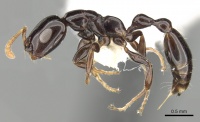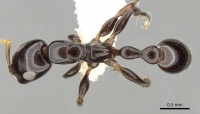Tetraponera bita
| Tetraponera bita | |
|---|---|

| |
| Scientific classification | |
| Kingdom: | Animalia |
| Phylum: | Arthropoda |
| Class: | Insecta |
| Order: | Hymenoptera |
| Family: | Formicidae |
| Subfamily: | Pseudomyrmecinae |
| Genus: | Tetraponera |
| Species: | T. bita |
| Binomial name | |
| Tetraponera bita Ward, 2001 | |
Lowery's Kota Kinabalu material was collected in gardens and relict rain forest. A queen from Pasoh Forest Reserve was collected in a dead twig in c. 32m height.
Identification
A member of the Tetraponera allaborans species-group
Ward (2001) - Workers of T. bita can be distinguished from those of other species, except T. brevis, by their broadly convex, crenulate and slightly protruding clypeal lobe; short, robust profemur; laterally rounded pronotum; and presence of a metanotal welt. The most striking difference between T. bita and Tetraponera brevis is the broader head of the latter (worker CI 0.82-0.84). For discussion of additional differences, see T. brevis.
Keys including this Species
Distribution
Known from two localities on the island of Borneo and one probable site on peninsular Malaysia.
Latitudinal Distribution Pattern
Latitudinal Range: 5.983333333° to -5.983333333°.
| North Temperate |
North Subtropical |
Tropical | South Subtropical |
South Temperate |
- Source: AntMaps
Distribution based on Regional Taxon Lists
Indo-Australian Region: Borneo (type locality), Indonesia, Malaysia.
Distribution based on AntMaps
Distribution based on AntWeb specimens
Check data from AntWeb
Countries Occupied
| Number of countries occupied by this species based on AntWiki Regional Taxon Lists. In general, fewer countries occupied indicates a narrower range, while more countries indicates a more widespread species. |

|
Estimated Abundance
| Relative abundance based on number of AntMaps records per species (this species within the purple bar). Fewer records (to the left) indicates a less abundant/encountered species while more records (to the right) indicates more abundant/encountered species. |

|
Biology
Castes
Worker
Images from AntWeb

| |
| Worker. Specimen code casent0281997. Photographer Shannon Hartman, uploaded by California Academy of Sciences. | Owned by NHMUK, London, UK. |
Nomenclature
The following information is derived from Barry Bolton's Online Catalogue of the Ants of the World.
- bita. Tetraponera bita Ward, 2001: 609, figs. 11, 22, 47 (w.q.) BORNEO.
Unless otherwise noted the text for the remainder of this section is reported from the publication that includes the original description.
There is one collection of a dealate queen from Pasoh Forest Reserve, Malaysia (leg. Rosciszewski) that matches reasonably well the paratype queen of T. bita, especially with respect to the clypeal margin (furnished with a pair of long, blunt mediolateral teeth and a much shorter, pointed median tooth, as in the bita paratype queen), elongate head (CI 0.62 compared with 0.60 in the paratype), broad profemur (FI 0.54, as in paratype ), and slender petiole (PLI 0.54 compared with 0.55 in the paratype), although the Pasoh queen is larger (HW 0.68 v. 0.61 in the paratype). The elongate head and slender petiole suggest that this queen is T. bita, not the related species, Tetraponera brevis.
Description
Worker
HW 0.63-0.65, HL 0.86-0.87, LHT 0.55-0.56, CI 0.73-0.75, FCI 0.12-0.13, REL 0.35-0.37, REL2 0.48-0.49, SI 0.58-0.59, SI3 1.19-1.21, FI 0.47-0.53, PLI 0.58-0.62, PWI 0.47-0.53, PDI 0.99-1.00, LHT/HW 0.85-0.86, CSC 2, MSC 2. Note: n = 2 for LHT and LHT/HW.
Median clypeal lobe crenulate, with about five blunt denticles, protruding slightly beyond the reach of the anterolateral clypeal margins; clypeal lobe somewhat broad and less sharply set off from the rest of the clypeus than in Tetraponera allaborans; eyes moderately large, especially in relation to head width (see REL2 values); pro femur short and broad (FI >0.46); pronotal dorsum rounding broadly into the sides; mesopropodeal impression relatively shallow, interrupted in the middle by a small, raised, transverse platform (apparent metanotum), which is joined to lateral ridges that arch forward; metanotum preceded and followed by longitudinally rugulate grooves, the posterior groove more deeply impressed than the anterior groove; propodeum low and broad, as wide as high (see PDI values), in profile its dorsal face rounding gradually into the declivitous face; petiole relatively short and broad (see indices). Integument smooth and shining, with scattered minute punctures (<0.010 mm in diameter) and very faint irregular lineations; lower malar area longitudinally carinate anteriorly. Standing pilosity (>0.07 mm in length) sparse, scattered on gaster and apex of head, also one supraocular pair, and one pair on the pronotum; 1-2 shorter standing hairs (0.05-0.07 mm in length) on the petiole and postpetiole; in addition, short (0.02-0.05 mm), sparse, inconspicuous appressed hairs scattered over the body, becoming suberect to erect on venter of the petiole and postpetiole. Medium to dark brown, antennae, mandibles and tarsi somewhat lighter.
Type Material
Holotype. Worker, Kota Kinabalu, Sabah, Malaysia, 20m, 5°59'S 116°04'E, 9.x.l978 (B. B. Lowery) (Australian National Insect Collection). Paratypes. 1 worker, 1 alate queen, same data as holotype (ANIC, Universiti Malaysia Sabah).
References
- Ward, P. S. 2001. Taxonomy, phylogeny and biogeography of the ant genus Tetraponera (Hymenoptera: Formicidae) in the Oriental and Australian regions. Invertebrate Taxonomy. 15:589-665. (page 609, figs. 11, 22, 47 worker, queen described)
- Ward, P. S. 2006. The ant genus Tetraponera in the Afrotropical region: synopsis of species groups and revision of the T. ambigua-group. (Hymenoptera: Formicidae). Myrmecologische Nachrichten. 8:119-130.
References based on Global Ant Biodiversity Informatics
- CSIRO Collection
- Katayama M., K. Kishimoto-Yamada, H. O. Tanaka, T. Endo, Y. Hashimoto, Sk. Yamane, and T. Itioka. 2015. Negative correlation between ant and spider abundances in the canopy of a Bornean tropical rain forest. Biotropica (in press).
- Pfeiffer M.; Mezger, D.; Hosoishi, S.; Bakhtiar, E. Y.; Kohout, R. J. 2011. The Formicidae of Borneo (Insecta: Hymenoptera): a preliminary species list. Asian Myrmecology 4:9-58
- Ward P. S. 2001. Taxonomy, phylogeny and biogeography of the ant genus Tetraponera (Hymenoptera: Formicidae) in the Oriental and Australian regions. Invertebrate Taxonomy 15: 589-665.
- Ward, P. S. 2001. Taxonomy, phylogeny and biogeography of the ant genus Tetraponera (Hymenoptera: Formicidae) in the Oriental and Australian regions. Invertebrate Taxonomy 15:589-665.
- Ward, P.S. 2001. Taxonomy, phylogeny and biogeography of the ant genus Tetraponera (Hymenoptera : Formicidae) in the Oriental and Australian regions. Invertebrate Systematics 15:589-665.

